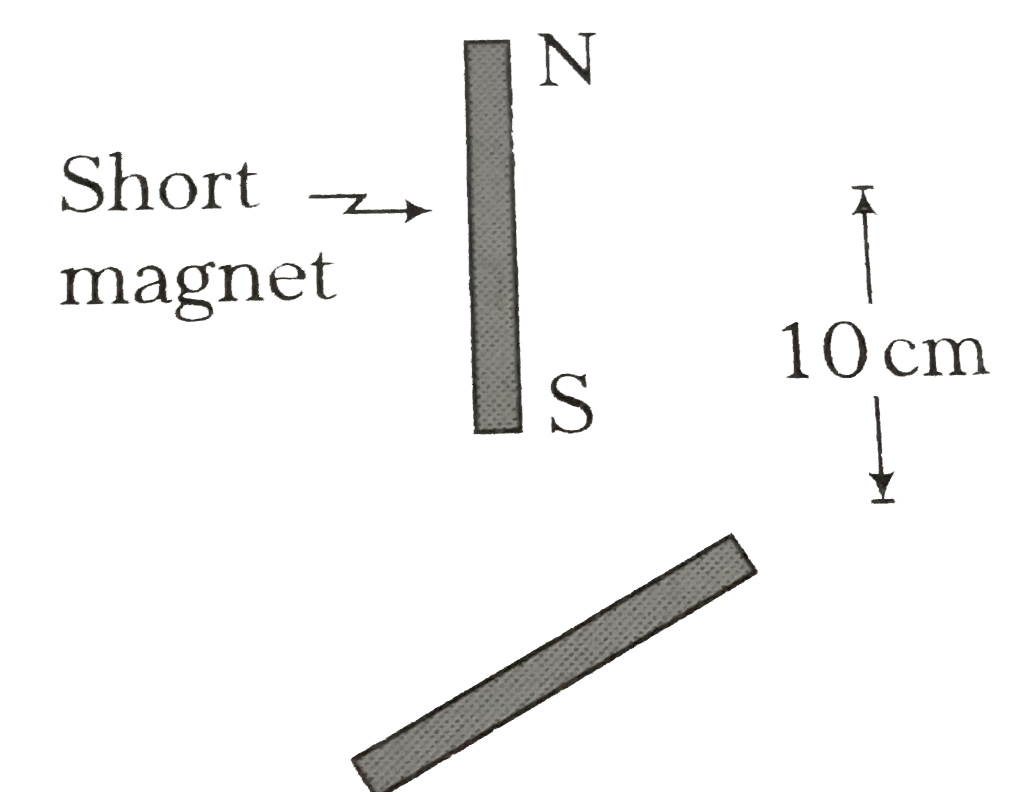The magnet of a vibration magnetometer is heated so as to reduce its magnetic moment by 19%. By doing this the period time of the magnetometer will
increase by 11%
decrease by 19%
increase by 19%
decrease by 11%
The correct Answer is:A
To solve the problem, we need to analyze how the magnetic moment of a vibration magnetometer affects its time period when the magnetic moment is reduced by 19%.
1. Understanding the Formula:
The time period T of a vibration magnetometer is given by the formula:
T=2π√IMB
where I is the moment of inertia, M is the magnetic moment, and B is the magnetic field. For our analysis, we will focus on the relationship between the time period and the magnetic moment.
2. Inversely Proportional Relationship:
From the formula, we can see that the time period T is inversely proportional to the magnetic moment M. This means that if the magnetic moment decreases, the time period increases.
3. Calculating the New Magnetic Moment:
The problem states that the magnetic moment is reduced by 19%. If we assume the initial magnetic moment M is 100 (for simplicity), the new magnetic moment M′ after the reduction will be:
M′=M−0.19M=100−19=81
4. Setting Up the Ratio of Time Periods:
The ratio of the original time period T to the new time period T′ can be expressed as:
TT′=√M′M=√81100=√0.81=910
5. Finding the New Time Period:
Rearranging the ratio gives us:
T′=109T
This indicates that the new time period T′ is greater than the original time period T.
6. Calculating the Percentage Increase:
To find the percentage increase in the time period:
Percentage Increase=(T′−TT)×100=⎛⎝109T−TT⎞⎠×100=(10−99)×100=19×100≈11.11%
Therefore, the time period increases by approximately 11%.
7. Conclusion:
The time period of the magnetometer will increase by approximately 11%.
Final Answer:
The time period of the magnetometer will increase by 11%.
The time period T of a vibration magnetometer is given by the formula:
T=2π√IMB
where I is the moment of inertia, M is the magnetic moment, and B is the magnetic field. For our analysis, we will focus on the relationship between the time period and the magnetic moment.
From the formula, we can see that the time period T is inversely proportional to the magnetic moment M. This means that if the magnetic moment decreases, the time period increases.
The problem states that the magnetic moment is reduced by 19%. If we assume the initial magnetic moment M is 100 (for simplicity), the new magnetic moment M′ after the reduction will be:
M′=M−0.19M=100−19=81
The ratio of the original time period T to the new time period T′ can be expressed as:
TT′=√M′M=√81100=√0.81=910
Rearranging the ratio gives us:
T′=109T
This indicates that the new time period T′ is greater than the original time period T.
To find the percentage increase in the time period:
Percentage Increase=(T′−TT)×100=⎛⎝109T−TT⎞⎠×100=(10−99)×100=19×100≈11.11%
Therefore, the time period increases by approximately 11%.
The time period of the magnetometer will increase by approximately 11%.
The time period of the magnetometer will increase by 11%.
Similar Questions
The magnet of vibration magnetometer is heated so as to reduce its magnetic moment by 36%. By doing this the periodic time of the magnetometer will
View SolutionFor a vibration magnetometer, the time period of suspended bar magnet can be reduced by -
View SolutionThe perio of oscillation of a magnet in vibration magnetometer is 2 sec. The period of oscillation of a magnet whosr magnetic moment is four times that of the first magnet is
View SolutionThe time period of the magnetic in an oscillation pmagnetometer in the earth magnetic field is 2s. A short bar magnet is placed to the north of the magnetometer, at a separation 10cm from the oscillation magnet, with its north pole pointing towards north. The time period beceomes half. Calculate the magnetic moment of this short magnet.

View SolutionThe time period of a vibration magnetometer is T0. Its magnet is replaced by another magnet whose moment of inertia is 3 times and magnetic moment is 1/3 of the initial magnet. The time period now will
View SolutionA vibration magnetometer is placed at the south pole, then the time period will be
View SolutionWith a standard rectangular bar magnet the time period of a vibration magnetometer is 4 s. The bar magnet is cut parallel to its length into four equal pieces. The time period of vibration magnetometer when one piece is used (in second) (bar magnet breadth is small) is
View SolutionThe period of oscillation of a magnet of a vibraion magnetometer is 2.45 s at ione place and 4.9 s at the other, the ratio of the horzontal component of earth magnetic field at the two places is
View SolutionThe magnetic needle of a vibration magnetometer makes 12 oscillations per minute in the horizontal component of earth's magnetic field. When an external short bar magnet is placed at some distance along the axis of the needle in the same line it makes 15 oscillations per minute. If the poles of the bar magnet are inter changed, the number of oscillations it takes per minute is
View SolutionA bar magnet of mass 100 g, length 7.0 cm, width 1.0 cm and height 0.50 cm takes π2 seconds to complete an oscillation in an oscillation magnetometer placed in a horizontal magnetic field of 25μT. (a) Find the magnetic moment of the magnet. (b) If the magnet is put in the magnetometer with its 0.50cm edge horizontal, what would be the time period?
View Solution
